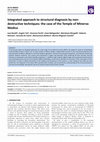Papers by Marina Magnani Cianetti
International Journal of Heritage Architecture: Studies, Repairs and Maintence, 2017

ACTA IMEKO, 2018
In the present paper an integrated approach of a wide range of non-destructive tests (NDTs) was a... more In the present paper an integrated approach of a wide range of non-destructive tests (NDTs) was applied to study an archeological ruined building located in Rome, the so-called Temple of Minerva Medica. Applied NDTs focused on the monument properties and environmental conditions affecting its structural behavior (geometry, thermal and mechanical properties, microclimatic monitoring, ambient vibration response). Two surveys were performed in August and December 2016 combining 3D laser scanning, thermal infrared, air temperature and relative humidity acquisitions. In addition, high resolution digital images were acquired and processed by stereo-photogrammetry Structure from Motion (SfM) methodology, carried out for detailed reconstruction of the crack pattern of the monument. In order to obtain information on the integrity and consistency of the masonry, a sonic testing of each pillar was also performed. The integration of the above NDTs provided quite complete and comprehensive under...

The Sustainable City XII, Sep 18, 2017
The coexistence of modern transport systems with the presence of cultural heritage sites in urban... more The coexistence of modern transport systems with the presence of cultural heritage sites in urban environments is a very crucial issue in sustainable city planning. In particular, in the historic centre of cities with plenty of scattered archaeological sites, such as Rome, urban traffic vibrations must be monitored to assure the conservation of ancient monuments. In fact, cultural heritage sites may suffer from traffic vibration impact in terms of aesthetical damages even in cases in which the structural health is not compromised. In such context, the present paper focuses on the impact of traffic vibrations induced on two monuments studied within the CO.B.RA. project (aiming at developing advanced technologies and methods for the conservation of cultural heritage). The so-called Temple of Minerva Medica and the Catacomb of Priscilla are exposed to different types of traffic vibration sources and are characterized by different structural conditions. Besides the ambient vibration monitoring, several non-destructive tests (NDTs) and noncontact investigations were conducted at the two sites in order to study the state of damage and the structural conditions of the two monuments. In particular, the ambient vibration monitoring gave remarkably different outcomes in these two cases and provided objective data for interesting observations on the sustainability of tramways, railways and road traffic near such diverse archaeological assets.

The building, known as the Temple of Minerva Medica, dates back to the 4th century A.D. The build... more The building, known as the Temple of Minerva Medica, dates back to the 4th century A.D. The building presents different critical aspects: first of all the monumental pillars rest on pre-existing archaeological sites and inhomogeneous layers of soils, moreover the integrity of the structure is endangered by severe vibrations induced by the frequent transit of the nearby trains and the local tramway. Due to the instability of the surviving portion of the dome (the main part collapsed in cia tion and consolidation interventions. These works restored the majesty and reliability of this monument that is undervalued and often forgotten. Onsite testing gained a fundamental role in the identification of the construction, in particular, Ambient Vibration Test (AVT) provides global information on the overall dynamic characteristics of the structures. This paper, through the case study of the Temple of Miner-va Medica, aims to prove the reliability of Operational Modal Analysis (OMA) in the identification of the dynamic behaviour of a large masonry building (natural frequencies, modal damping and modal deformations). Two sets of measurements were recorded by the laboratory of Proof testing and Research on Structures and Material (PRiSMa) sonable number of accelerometers, were suitably positioned and the dynamic response of the structure to wind and the surrounding traffic was recorded; the measurements of the two halves of the temple were processed and later merged through the Multi-Run technique in order to identify the dynamic behaviour of the entire structure.











Uploads
Papers by Marina Magnani Cianetti